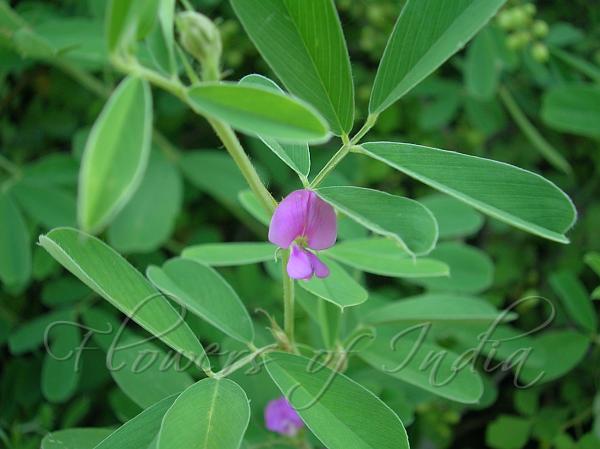|
| Common Tephrosia |
|

|

| File size | 685421 |
| Original date | 7/27/05 5:13 PM |
| Resolution | 2048 x 1536 |
| Flash | Flash did not fire, auto |
| Focal length | 8.0mm |
| Exposure time | 1/96s |
| Aperture | 3.2 |
| Focus Distance | |
| Metering Mode | Partial |
| Camera make | NIKON |
| Camera model | E3700 |
| Sensor type |
|
|
|
|
Photo: |
Botanical name: Tephrosia purpurea Family: Fabaceae (Pea family)
Synonyms: Tephrosia lanceifolia, Tephrosia indigofera, Tephrosia wallichii
Synonyms: Tephrosia lanceifolia, Tephrosia indigofera, Tephrosia wallichii
Common Tephrosia is a perennial erect or prostrate
herb or subshrub, up to 50 cm tall. Leaves are compound, leaflets 7-15,
1-2.8 x 0.3-1 cm, inverted-lanceshaped or obovate, base wedge-shaped,
tip blunt to notched or flat, with a short sharp point; stipules 3-6 mm
long, lanceshaped. Flowers are about 7 mm long, in few-flowered,
leaf-opposed, raceme-like clusters. Flower-stalks are 3-4 mm long;
bracts about 2 mm long. Calyx is 3-4 mm long, velvet-hairy; sepals
tapering to a point. Flowers are pink to purplish, pea-flower shaped.
Standard is about 4 mm broad, round. Staminal tube to 4 mm long. Pods
are 2.5-4 cm long, 3-4 mm broad, linear-oblong, 5-7-seeded. Seeds
ellipsoid, dark brown. Common Tephrosia is found in Indo-Malesia,
including the Himalayas & the Western Ghats. Flowering: March-October.
Medicinal uses: According to Ayurveda, plant
is digestible, anthelmintic, alexiteric, antipyretic, alternative,
cures diseases of liver, spleen, heart, blood, tumours, ulcers,
leprosy, asthma, poisoning etc. According to Unani system of medicine,
root is diuretic, allays thirst, enriches blood, cures diarrhea, useful
in bronchitis, asthma, liver, spleen diseases, inflammations, boils and
pimples; Leaves are tonic to intestines and a promising appetizer. Good
in piles, syphilis and gonorrhoea.
According to Ayurveda, plant
is digestible, anthelmintic, alexiteric, antipyretic, alternative,
cures diseases of liver, spleen, heart, blood, tumours, ulcers,
leprosy, asthma, poisoning etc. According to Unani system of medicine,
root is diuretic, allays thirst, enriches blood, cures diarrhea, useful
in bronchitis, asthma, liver, spleen diseases, inflammations, boils and
pimples; Leaves are tonic to intestines and a promising appetizer. Good
in piles, syphilis and gonorrhoea.
Medicinal uses:
 According to Ayurveda, plant
is digestible, anthelmintic, alexiteric, antipyretic, alternative,
cures diseases of liver, spleen, heart, blood, tumours, ulcers,
leprosy, asthma, poisoning etc. According to Unani system of medicine,
root is diuretic, allays thirst, enriches blood, cures diarrhea, useful
in bronchitis, asthma, liver, spleen diseases, inflammations, boils and
pimples; Leaves are tonic to intestines and a promising appetizer. Good
in piles, syphilis and gonorrhoea.
According to Ayurveda, plant
is digestible, anthelmintic, alexiteric, antipyretic, alternative,
cures diseases of liver, spleen, heart, blood, tumours, ulcers,
leprosy, asthma, poisoning etc. According to Unani system of medicine,
root is diuretic, allays thirst, enriches blood, cures diarrhea, useful
in bronchitis, asthma, liver, spleen diseases, inflammations, boils and
pimples; Leaves are tonic to intestines and a promising appetizer. Good
in piles, syphilis and gonorrhoea. | Identification credit: Nandan Kalbag | Photographed in JNU campus, Delhi & Maharashtra. |
• Is this flower misidentified? If yes,